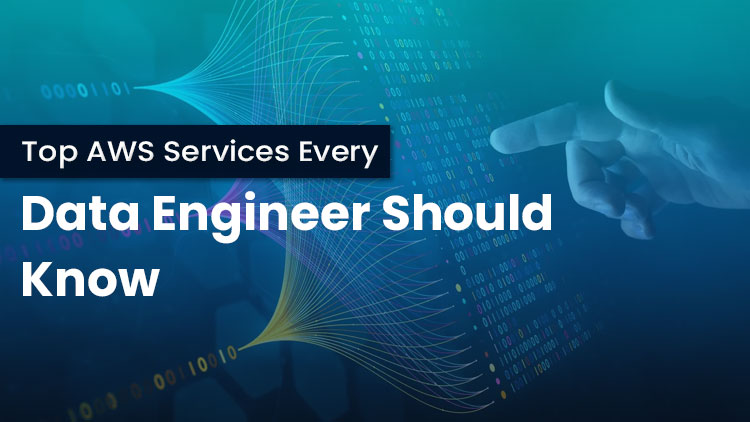
Top AWS Services Every Data Engineer Should Know

Introduction
In the data-intensive world of today, the job of a data engineer has gained importance in determining how companies deal with and make use of their data. As data grows exponentially, efficient, scalable, and reliable infrastructure becomes more necessary than ever before. That is where Amazon Web Services (AWS) comes into the picture, providing a broad spectrum of cloud services specifically designed for data storage, processing, analysis, and security.
Enhance your knowledge of AWS data services with VERSAtile Reads’s comprehensive exam prep resources. Access structured exam cram notes, practice questions to build a strong foundation for your certification journey. In this blog, we’ll explore important AWS services that are essential for Data Engineers, offering valuable insights and knowledge to boost your success in the field.
Why AWS for Data Engineering?
Before we dive into the individual services, let’s spend a moment discussing why AWS is the first choice for data engineering:
- Scalability: AWS provides elastic infrastructure that scales up or down according to demand, which makes it ideal for managing enormous datasets.
- Cost Efficiency: With pay-as-you-go and numerous cost management options, AWS charges you only for what you consume.
- Security: AWS offers best-in-class security features such as encryption, identity management, and compliance certifications.
- Integration: AWS services are purpose-built to integrate well with one another, making it easy to build end-to-end data pipelines.
- Reliability: AWS provides high availability and fault-tolerant infrastructure, so your data will always be available and secure.
Must-Have AWS Services for Data Engineers
1. Amazon S3 – Scalable Object Storage
Amazon S3 is one of the most popular services in AWS, and for a great reason. It provides highly scalable, secure, and durable object storage, ideal for storing data lakes and unstructured data such as logs, images, and backups.
Major Features:
- Durability: 99.999999999% (11 nines) durability protects data.
- Scalability: Process petabytes of data without any performance lag.
- Lifecycle Policies: Automate data archiving and deletion to control costs.
- Versioning: Store and retrieve previous versions of your data objects.
Why It Matters:
For data engineers, S3 is a one-stop repository for storing raw data prior to its transformation and analysis. It works well with several AWS analytics and processing services and thus forms a foundation of any data pipeline.
2. AWS Glue – Serverless Data Integration
AWS Glue is a serverless ETL (Extract, Transform, Load) service that streamlines data preparation and consolidation. It mechanizes much of the time-consuming effort associated with data discovery, cataloging, and schema changes.
Key Features:
- Serverless: No management of infrastructure necessary.
- Data Catalog: Unified metadata store for seamless data discovery.
- Flexible Scripting: Python and Spark support for writing custom ETL scripts.
- Job Scheduling: Schedule ETL jobs with dependency management.
Why It Matters
Glue simplifies the ETL process for data engineers, making data clean, structured, and ready to be analyzed. Integration with services such as S3 and Redshift simplifies the creation of automated pipelines.
3. Amazon Redshift – High-Performance Data Warehousing
Amazon Redshift is a managed data warehouse service for large-scale, fast analytics. Leverage columnar storage and parallel query execution for high performance on large datasets.
Key Features:
- Massive Scalability: Enables petabyte-scale data warehouses.
- Fast Queries: Columnar storage and compression minimize I/O.
- Redshift Spectrum: Query S3 data without unloading it into Redshift.
- Integration: Seamlessly integrates with BI tools such as Tableau and Power BI.
Why It Matters:
Redshift is great for data engineers creating data marts and executing complex analytical queries. Its cost-effectiveness and performance make it ideal for big business intelligence projects.
4. AWS Lambda – Serverless Data Processing
AWS Lambda lets you execute code without having to provision or manage servers. It’s event-driven, so it runs automatically when triggered by events such as file uploads or database changes.
Key Features:
- Event-Driven: Invoke functions from S3, Kinesis, DynamoDB, and others.
- Auto-Scaling: Automatically scales according to demand.
- Flexible Runtime: Python, Node.js, Java, and many others.
- Cost Efficiency: Pay only for execution time and memory.
Why It Matters:
For data engineers, Lambda is perfect for lightweight ETL tasks, real-time data processing, and automating workflows. Its event-driven model simplifies data pipeline orchestration.
5. Amazon Kinesis – Real-Time Data Streaming
Amazon Kinesis makes it easy to collect, process, and analyze real-time streaming data. Whether it’s application logs, IoT device data, or event tracking, Kinesis handles high-throughput streams efficiently.
Key Features:
- Real-Time Ingestion: Process data as it arrives.
- Integration: Works with AWS Lambda, S3, and Redshift.
- Scalability: Handles thousands of data records per second.
- Data Retention: Store data streams for up to seven days.
Why It Matters:
Kinesis is essential for real-time analytics, enabling businesses to react quickly to trends and insights. Data engineers can use it to build low-latency data pipelines.
6. AWS Data Pipeline – Orchestrating Data Workflows
AWS Data Pipeline automates the movement and transformation of data across AWS services. It simplifies complex workflows by scheduling and monitoring ETL jobs.
Key Features:
- Flexible Scheduling: Automate data movement with defined intervals.
- Error Handling: Built-in retry and alert mechanisms.
- Data Integration: Works with S3, RDS, DynamoDB, and Redshift.
- Custom Scripts: Supports Python and Shell scripts.
Why It Matters:
Data engineers can automate data workflows, reducing manual effort and ensuring consistency in data processing.
7. Amazon DynamoDB – NoSQL Database for Big Data
DynamoDB is a managed NoSQL database offering high performance and scalability. It supports key-value and document-based data models.
Key Features:
- Low Latency: Millisecond response times.
- Auto-Scaling: Adjusts throughput based on demand.
- Serverless: Fully managed with no infrastructure to maintain.
- Backup and Restore: Point-in-time recovery and on-demand backups.
Why It Matters:
DynamoDB is ideal for high-velocity data applications, such as caching layers, user activity tracking, and IoT systems.
8. AWS Lake Formation – Building Secure Data Lakes
AWS Lake Formation simplifies the creation and management of secure data lakes. It automates data ingestion, transformation, and access control.
Key Features:
- Centralized Data Management: Unified data lake architecture.
- Automated Ingestion: Simplifies data onboarding.
- Fine-Grained Permissions: Control access at the table and column level.
- Data Catalog Integration: Works seamlessly with AWS Glue.
Why It Matters:
Data engineers can quickly set up scalable and secure data lakes, making data accessible across the organization.
9. Amazon EMR – Big Data Processing with Hadoop and Spark
Amazon EMR is a managed big data platform that supports Apache Hadoop, Spark, and other frameworks. It simplifies large-scale data processing and analytics.
Key Features:
- Cost Efficiency: Pay-per-second billing.
- Scalability: Add or remove nodes based on workload.
- Flexibility: Supports popular big data frameworks.
- Integration: Works with S3, DynamoDB, and Redshift.
Why It Matters:
EMR provides the power of distributed computing without the complexity of managing Hadoop or Spark clusters.
Conclusion
AWS offers a comprehensive set of tools for data engineers, enabling efficient data storage, transformation, and analysis. Mastering these services ensures you can build scalable, secure, and cost-effective data pipelines tailored to your organization’s needs.
FAQs
1. What is the best AWS service for real-time data processing?
Amazon Kinesis is perfect for real-time data streaming and analytics, offering low-latency data ingestion and processing.
2. How does AWS Glue simplify ETL workflows?
AWS Glue automates schema discovery, data cataloging, and transformation, reducing manual effort in building ETL pipelines.
3. Why choose Amazon Redshift for data warehousing?
Redshift’s columnar storage and parallel query execution make it fast and cost-efficient for large-scale analytics.
- Published Date:



